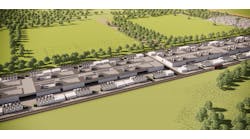James Fine, EDF senior economist
Would pricing clean energy through a ‘smart home rate’ work? James Fine, EDF’s senior economist, describes the intriguing possibility being explored in California.
Industrial and environmental stakeholders are usually portrayed as adversaries. But one exciting example from California proves there can be another side to that story. San Diego Gas & Electric (SDG&E) worked with Environmental Defense Fund, Sunverge, Google, and the California Public Utility Commission at Rocky Mountain Institute’s eLab Accelerator to investigate electricity tariffs that enable new technologies and practices and to reveal their costs and benefits to the grid. As distributed energy resources (DERs) continue to grow rapidly, there is increasing need to enable the marketplace to value utility-supplied grid services and customer-sited resources.
SDG&E serves 3.4 million people in and around San Diego, and is also home to roughly 10,000 electric vehicles and 40,000 rooftop solar systems. SDG&E is responsible for keeping the lights on despite growing demand (the region has one of the largest EV adoption rates in the nation) and variable electricity generation (PV panels stop producing at sunset).
Rather than resisting these changes, SDG&E has been working collaboratively to explore a vision of a future with even greater quantities of distributed energy resources. That vision looks at several features:
- Tariff options available for customers to buy or sell services to or from the electricity grid.
- Customer rate options that are unbundled sufficiently to align with current or future technology capabilities, and broken out by attributes of interest, such as capacity, energy, and ancillary services.
- Pricing by time, location, cleanliness, and power quality.
- Valuing electricity generation and demand-side resources consistently based on the energy attributes they provide.
- A menu of tariff options that
— keep it simple for customers who want simplicity;
— provide clear ways for customers to save money, including controllable set-it-forget-it technologies;
— enable meeting state and federal environmental and other policy goals;
— address the special needs of customers; and
— provide a seamless gateway for DERs to realize their benefits.
Embarking with this vision in mind, the group defined a structure to be available optionally to customers interested in using technologies and/or practices to provide products and services to the grid. The key is to accurately reflect the costs and benefits, while allowing for the great diversity of customer interests and capabilities.
Toward a shared goal of enabling high penetration of DERs through a menu of gradually-introduced rate options and credit mechanisms, the team conceptualized one rate option. Dubbed the “Smart Home Rate”, the tariff would be geared toward adopters of any number of distributed resources (for example: distributed generation, energy efficiency, demand response, storage, smart thermostats, and electric vehicles) including those that enable automated responses to grid signals and market prices.
The structure seeks to fairly compensate customers, the utility, and third-party participants for the full range of services they provide. Essential components include:
- A monthly service fee ($/meter) to cover customer costs such as the meter and a customer contact center
- A grid charge that allows customers to benefit by managing their load profile
- A day-ahead hourly price signal ($/kWh) that allows customers to utilize technologies to both avoid periods of high costs/high demand and benefit from utilizing energy during negative pricing events that occur during periods of low loads and high renewable supply
There is still a lot of work to do to refine these tariff components and to make an option like the Smart Home Rate available to SDG&E customers. Yet we all can see the benefit of offering customers the choice to adopt new technologies in a way that will reduce their bill and utility costs. While such collaboration might not grab headlines, it can certainly be an important reason to have great optimism for the future of clean energy.
The eLab Accelerator team included the two authors; Kurt Adelberger, a principal with Google; Jon Fortune, Director for Regulatory and Energy Services at Sunverge Energy; and Gabe Petlin, Senior Analyst for the California Public Utilities Commission.
This post was co-written by Chris Yunker, Rates and Analysis Manager at San Diego Gas & Electric. It originally appeared on the Rocky Mountain Institute blog.








